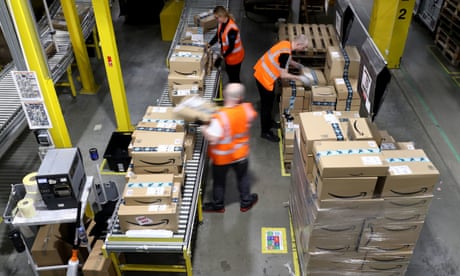Amazon workers say they are working in a “sweatshop” as safety concerns and worries about the cost of living crisis have triggered walkouts at warehouses around the country. The Observer has spoken to four staff involved in the walkouts, who work at three Amazon warehouses, including Tilbury in Essex, where protests began on 4 August. All say they will struggle to survive this winter with pay rise offers between 35p and 50p an hour – far less than the rate of inflation, which is currently at 13%.
The workers, who spoke anonymously for fear of reprisals from Amazon, said they were speaking out to highlight how the firm’s ultra-cheap, ultra-convenient, super-fast delivery model works. Amazon employs more than 70,000 people in the UK, adding 25,000 staff in 2021 alone. Many work at the company’s 21 fulfilment centres, where some workers say they are asked to carry out long, physical shifts, with difficult targets, for low pay.
Starting pay in Amazon warehouses will shortly be increasing to between £10. 50 and £11. 45 per hour, depending on location.
An Amazon spokesperson said this was a 29% increase in the minimum hourly wage paid to staff since 2018. They said it is also augmented by a comprehensive benefits package worth thousands of pounds a year, and a company pension plan. But staff say it is too low for the type of work being done and given the current economic crisis, especially at a company that just posted $121bn (£100bn) in revenues in the second quarter of 2022 alone.
“When we heard the news, it was shocking,” said one worker at Amazon’s warehouse in Tilbury. “It’s ridiculous. Inflation is 13%, and our salary increases barely 3%.
” The worker rents a house with her husband for £1,350 a month without bills. “My salary is £1,600. … I’m lucky I’m married, otherwise I’d be homeless.
” Some staff are seeking a pay rise of £2 an hour from the tech giant. 00:45 Hundreds of Amazon employees stop working over disputed pay rise – video Another worker at Amazon’s warehouse in Tilbury said they were “petrified” about how they would survive this winter. “We had a scenario recently where someone was living in [an] Amazon [warehouse],” he said.
“If I’m honest, I can probably see that happening again. “I can see people staying in the canteen all the time because they can’t afford to go home. ” The worker is protesting against the poor pay offer, as well as conditions that lock staff in cages for entire shifts at the warehouses, from where they pick items to be delivered to customers.
(Amazon says the workstations are to protect workers from moving robotics. ) “It’s a Chinese sweatshop in the UK,” said the second worker at Tilbury. “It’s how they set up their model.
” The worker has struggled with his mental health while working for the company. “I’ve realised how bad Amazon is for my mental health,” he said. “The anxiety of going into work, knowing you’ve got to do the same stuff day in, day out, is horrible.
” That concern is echoed by a worker at an Amazon facility near Bristol, who has worked there with his wife for three years. “It was good initially,” the worker said. “There was a lot of safety consciousness, and the targets were pretty reasonable.
But now they’re just pushing it higher and higher, and exploiting people. ” Around 100 Amazon staff at Bristol staged a sit-in at the company canteen on 10 August – action for which they say they were docked pay by management at the site. “The vast majority of people went back to work at that point, because at the end of the day, as much as they want to fight for it, they have to think about themselves financially.
” The Bristol warehouse worker says that managers used to stop employees from lifting heavy items from bins on high shelves in the warehouse without a ladder. “If you overstretched yourself for 10 hours, you’d end up with a bad neck and a bad back,” he said. That has subsequently changed as staff said they felt pressured to meet ever-escalating demand.
Staff pushing carts around the warehouse used to be limited to using one cart at a time for safety reasons; now it is claimed managers turn a blind eye to staff pulling two carts at once. “They don’t say nothing because all they care about is getting the work done as fast as possible,” he said. “Safety just goes out the window.
” He says he has personally lifted items weighing up to 25kg by himself, despite rules saying anything heavier than 15kg should be lifted by two people. A worker at an Amazon facility in the north-west of England said that managers at his warehouse similarly ignored rules around not running on site and lifting down heavy items from high areas in an attempt to meet targets, which at his site require two items to be picked every minute. Amazon declined to respond to specific claims.
Martha Dark, director at Foxglove, a non-profit organisation working to highlight issues within tech companies that supports Amazon workers, said: “None of the workers we’re supporting wanted to protest. “They’re desperate and can’t survive on these wages. Meanwhile, Amazon threatens to dock pay and send workers to HR for revealing the truth about life in the warehouse.
” She added: “Amazon needs to respect workers’ rights to organise, stop penalising people who are fighting to survive and provide a real pay rise now. ” Two workers said they plan to leave the company because of the conditions and pay. However, some hope to stay put – to change things.
“If a lot of us who are experienced leave Amazon at this point they’ll get a new group of people in who they can mould into this depressing way of work,” said the Bristol worker. “That’s the problem. ”.
From: theguardian
URL: https://www.theguardian.com/uk-news/2022/aug/14/a-sweatshop-in-the-uk-how-the-cost-of-living-crisis-triggered-walkouts-at-amazon



